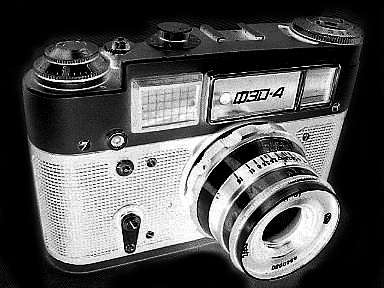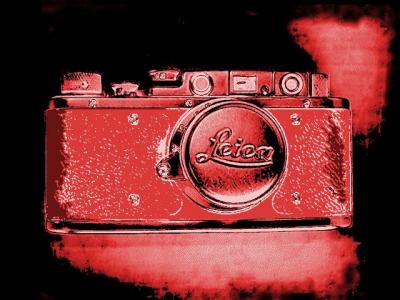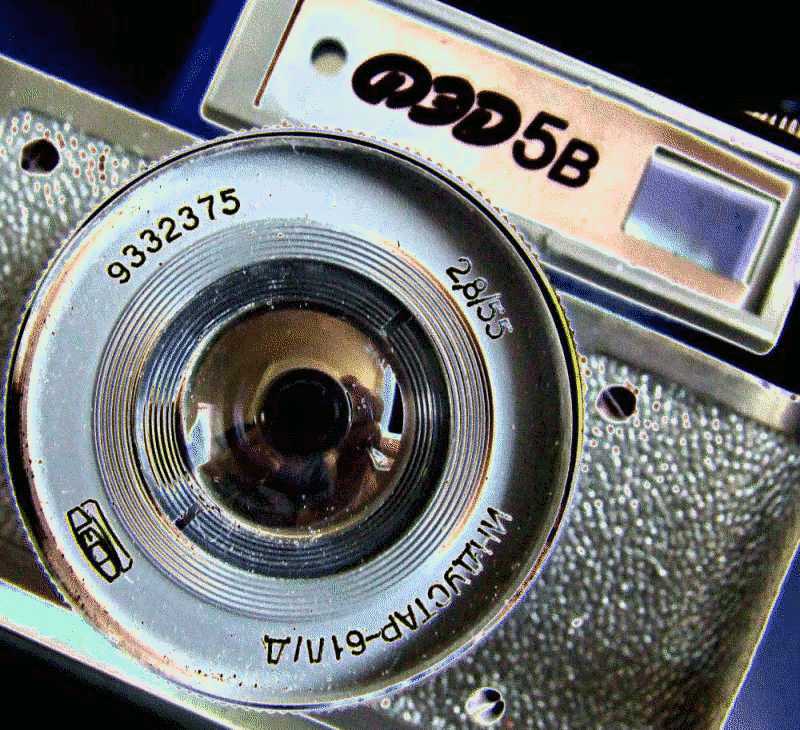|
|
FED 4 & 5 A LOST OPPORTUNITYI was not looking forward to doing this part of the project as I cannot really get that excited about these later FED cameras. Looking at FED rangefinder history it appears to me that they gave up trying to do anything new with the design and it stagnated over the last thirty odd year of production. Now in 2007 it looks as if they lost an opportunity that other manufacturers such as Voightlander with its Bessa R and L bodies have managed exploit.The FED-4 & 5 are are very weighty 35mm rangefinder cameras. There all metal body sees to that, along with the strength and structural rigidity that makes them feel like a brick in the hand. These are heavy ugly beasts with a solidity which inspire a certain confidence in there reliability. In the case of the FED-5 they look like a modern Leica M series camera with a very stylish black on metal look. What makes them special is that you can fit Leica Leitz screw mount lenses on a camera body that costs next to nothing to purchase. These cameras feel and look just as if they were a very expensive modern rangefinder however are sold at car boot sales and on ebay for the same price as a disposable camera. The FED-4 & 5 design apart from the exposure meter found on most models is more or less identical to the previous FED-3. As here we are talking about the final versions of this camera I would advise the reader to follow the links to the FED-1, FED-2 and FED-3 for a detailed account of the development history. 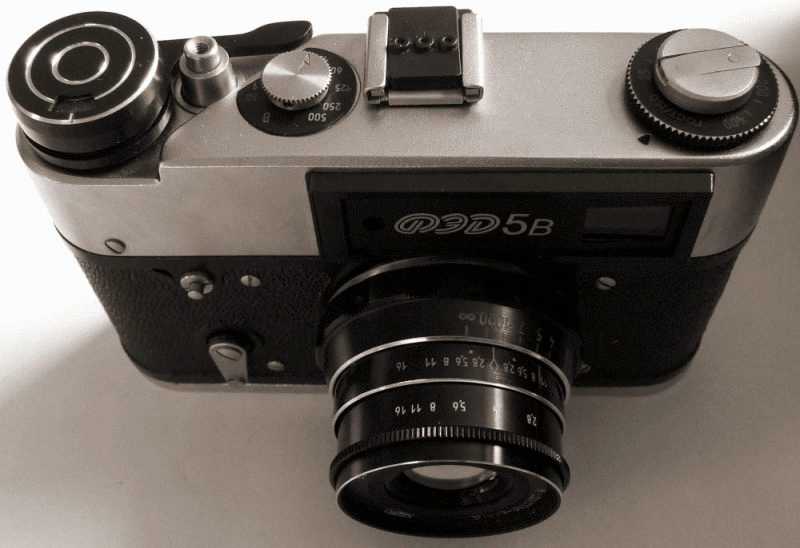 The
camera photographed
above and in the main text with the Industar-61L/D f2.8 55mm
lens is my
own
FED-5 type B Serial
Number (SN) 439781
which I think dates from 1994. The camera came with its
original box, case and instruction manual.
Recently I
discovered something new about the FED camera history and it came as a
bit of a shock. Members of the Zenit Camera Forum pointed out that in
2001 they produced a prototype FED-6 TTL prototype camera and
a set of lenses to be used with it. The
proposed new features for the camera were to be a new modern design
with TTL and an electronic shutter of 8sec to
1/2000th Photos
of FED-6 TTL c2001
& Photographs of
FED-6 TTL
c1992. The
camera is very similar in specification to the Voightlander
Bessa R and unfortunately they only produced ten cameras.
Also
separate to this they produced some Leica bayonet FED
M Mount Lenses.
UNJUSTIFIED REPUTATIONOver the years the poor quality of Soviet made cameras has been a focal point in the photographic press of why you should not purchase one. This is an unfair reputation not based on fact and does not in any way reflect my experiences and that of other users. In use these Soviet cameras feel and perform just like any screw mount Leica and have improved on the basic design to a point which nearly equals that of the later Leica bayonet M series. These improvements include combined viewfinder rangefinder, first class slow speed mechanism, lever wind, exposure meter not requiring a battery and most importantly a selection of superb lensesAt least FED finished production on a high point unlike Leica who now appears to have serious problems with their new digital M8 rangefinder. To a lot of users the M8 has been a major disappointment and has the most appalling quick fix of a sticking plaster type of approach which is something I have never seen on a Soviet made camera. To fix a serious design flaw with magenta required a horrible pink special IR filter to be used at all times! Another by product of using the filter I am told in low light creates incredible noise at higher ISO and users should ditch the filter and fix the problems in photo editing software. Many Leica users talk about how splendid this M8 is, reminding me of the fable of "the emperor's new clothes". If you say nice things long enough, no one will say what's really on their mind for fear of being called a fool or a heretic. This was not the only problem Leica has so just to put the record straight I will have a small dig at the master of camera design. The Leica M6 has apparently suffered from plastic film counter gears that would break! There was apparently a small batch of M6 cameras which passed quality control with film pressure plates that would scratch the film emulsion. There was also many M6 cameras which would run the batteries down and the electronics had to be redesigned. Then there was a problem in the M5 with an unreliable TTL metering mechanism that used a swinging arm in front of the shutter blinds. This obviously would make contact with a collapsable lens - nobody is perfect! The official advice was to tie tape around the lens so it would not collapse into the camera body. The M5 camera may have been a commercial failure and was withdrawn from sale in 1977. Leica it seems as a result stopped making rangefinder cameras for two years concentrating on there SLR range.. Interestingly the Leica II and III models do not appear to have any major quality problems so it may all be down to the complexity of the newer designs. This is not what you expect from the best camera manufacturer in the world. With a reputation like this it becomes apparent that Soviet made cameras are not as bad as we are led to believe by the photographic press. How many Soviet made cameras and sets of lenses can you purchase for the cost of a single Leica M8 body? My Soviet manual film camera will working many years after the last M8 has been discarded for the next throw away digital camera. 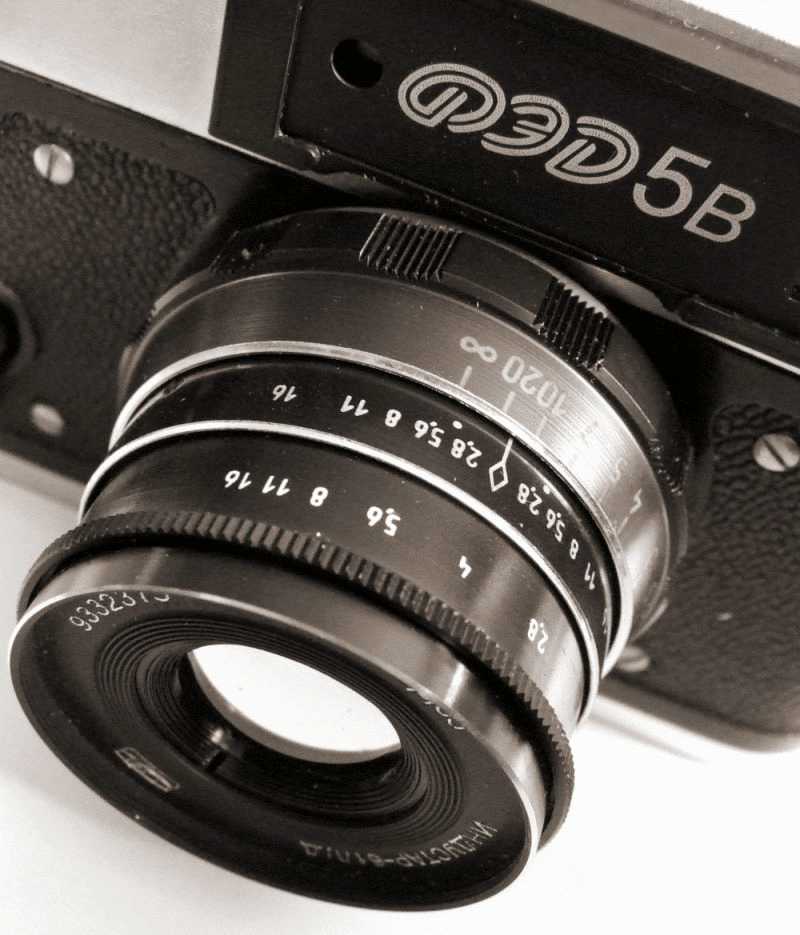 Above
photograph shows the Industar-61L/D f2.8 55mm
lens. his Industar-26m lens is a
re-engineered Industar-50 and of
Zeiss Tessar origin. One
of the unknown outcomes of the Great
Patriotic War (WWII) was the Soviet cameras
industry
access to superb Carl
Zeiss optics. When hostilities ceased in 1945 the heart of
the German camera industry found itself in the Soviet Zoneand
they promptly made use of all this new technology which also
spawned a whole series of modern new Soviet camera designs. The vast
majority of Soviet camera lenses can be traced back to this period. The
Industar-61L/D f2.8 55mm can be the equal in optical quality of a Leitz
Elmar f2.8 50mm.
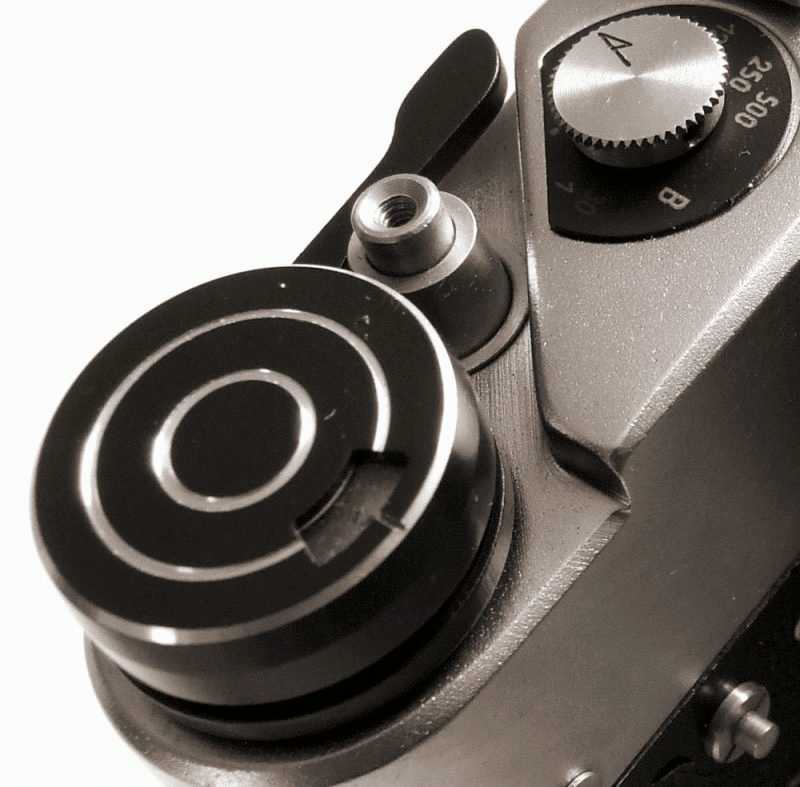 Above photograph showing the film counter, lever wind and shutter speed setting dial. FED DREAM CAMERAThe latest
FED camera should have had a modified cheap simple TTL metering system
with a LED display pinched from some other camera system. They should
have ditched the slow speeds mechanism and modified the shutter
to include 1000th, albeit I am informed by the experts on the Zenit
Camera Forum that this slow speed mechanism is supurb. The
body size
could maybe have been reduced to the previous
FED-2 size. They should have also fitted a Leica M bayonet mount and
supplied each camera with a cheap plastic 39mm screw mount adapter
that locked firmly into the camera body. Obviously a range of FED or KMZ
lenses with the M bayonet mount or supply all the lenses with a
cheap plastic adapter which you could lock onto the lens, unlike on
the real Leitz adapters where the damn things always come loose.
This sounds expensive but as the camera was going to be cheap anyway regardless of real production costs (due to the Soviet system) why not produce something that would have been modern. In 1930's 40's and early 50's they did a great job of keeping up with Leica. If they had followed another development path they may have made a real name for themselves. A FED-6 TTL with either Leica M or Contax bayonet mount! A FED-8 with a simple 3.1mp digital body again with the either Leica M or Contax bayonet mount! We can all dream about how it should have been and all have ideas of our own of the perfect camera. FED 4 & 5 DEVELOPMENT HISTORYThe FED-4 & 5 design was a logical development of the previous FED-3. It was an attempt to modernize the basic design and make the camera appear more like a more modern design . It For those who are unaware the FED initials stand for Felix Edmundovich Dzerjinski (1877-1926) the founder of the Soviet Secret Police. The FED 4 & 5 was in reality just a FED 3 camera with an exposure meter, lever wind and rewind crank. In 2001 they produced 10 prototype FED-6 TTL camera based on the 5 body.COLLECTORS GUIDEThe following types unless otherwise stated are nomenclature used by collectors as no FED-4 camera was actually marked in this way. FED 5 cameras were mrked at the factory as stated here. I have included some brief descriptions so as to ease identification. 4a 1964 - 71 Based on FED-3 type b body with a Selenium exposure meter in a raised top albeit still with a film advance knob. Fitted with Industar-61 lens. 4b
1969-76 Based on FED-4a with lever film advance
mechanism. Some minor modifications in 1970 including a new mechanism
to prevent the release of a partially cocked shutter and the possible
jamming that could occur. 5B 1975-90's New cocking lever and rewind crank. No exposure meter. Streamlined detail parts to ease production. Fitted with Industar-61 L/D lens. 5 1977-90's FED-5B with exposure meter and flush fitting rewind crank. 5C 1977-90's Economic version of of FED-5C with luminescent viewfinder and without dioptic adjuster FED-6 TTL 1992-2001 prototype with TTL metering based on FED-5B body - 10 manufactured. The proposed new features for the camera were to be a new modern design with TTL and an electronic shutter of 8sec to 1/2000th. Photographs of FED-6 TTL c2001 & FED-6 TTL c1992? & Technical DrawingsFED-7 1968-69 prototype fed-5b with hinged back. Note: The following table when completed will give a rough idea of numbers manufactured per year. FED
4 & 5 SERIAL NUMBERS - PRODUCTION NUMBERS 4a
- 1964-71 230k 6 TTL - 10 prototypes (1992-2001) Serial number information not known. Please note that these serial numbers are approximate as is the estimate production numbers. It is also a work in progress as unlike the FED-1 there appears to be no detailed information available. Total FED 4 and 5 production is known to be in the region of 1.7 million cameras. If you are going to invest in one Soviet Camera Collectors book the Princelle Guide is the one to go for: The
Authentic Guide To Russian and Soviet Cameras LENS TYPE INFORMATION52mm f2.8 Industar-61 f2.8 52mm(52.4mm) lens with rare earth slightly radioactive Lanthane elements. Some FED-2 camera bodies when fitted with this lens marked FED-2L. Later versions of this lens as fitted to FED-3, 4 and 5 were marked Industar-61L\D. 50mm f2.8 Industar-26m f2.8 50mm(52.4mm) lens. Fitted to FED-2 from 1956. This lens is based on a Zeiss Tessar KMZ made rangefinder lenses would also fit the FED-2 camera. These briefly being: 20mm f5.9 Russar 28mm f6 Orion 35mm f2.8 Jupiter-12 50mm f1.5 Jupiter-3 50mm f2 Jupiter-8 85mm f2 Jupiter-9 135mm f4 Jupiter-11 TECHNICAL SPECIFICATIONAn improved development of the 1961 FED-3.Manufactured 1961 - 1980 (Spec as 1961 FED-4 type a) Selenium exposure meter in a raised top Shutter is cloth focal-plane Shutter speeds: B - 1/2th, 1/4th, 1/8th 1/15th, 1/30th, 1/60th, 1/120th, 1/250th, 1/500th. Film is standard 35mm Loading via. a removable Contax style back. Lens - Industar-61 f2.8/52mm (52.4mm) Aperture settings: f2.8, f4, f5.6, f8, f11 and f16 Focusing: 1 M to infinity. Lens is screw mount 39mm X 26 tpi (not 1mm) Leica-type. Weight approximately ? Notes: FED-4 & 5 LINKSFED-4
Owners Manual
& FED-5
Owners Manual WARNINGWARNING you must not point the camera at the sun as it will burn a hole through the shutter curtain! Always use a lens cap.CHECKING YOUR CAMERAIf you are collecting these cameras for use and not display then you need to check very carefully the following areas or confirm with seller before purchase that camera is fully functional. The main problem area on these cameras is perished Shutter Curtains that need checking for holes and ripples. You will need to remove the camera back and unscrew the lens and remove it from the camera. You can then examine both sides of the shutter curtains which can be observed from the back and through the aperture in the camera front. You must examine both the first and second curtains very carefully. The second curtain can be viewed when you cock the shutter, and the first curtain after you release the shutter. If you use a small very bright torch in a dark room you can insert the torch through the lens aperture in the camera front taking care not to touch or damage the shutter curtain. Look for leaks from the camera back, these normally look like small pin holes of light - remember to check both shutter curtains. Rangefinders need to be checked for brightness and double image alignment both in the horizontal and vertical plane. The double Image needs to be checked it is adjusted correctly and that it is bright and usable. Sometimes the range finder mirrors are dirty resulting in the double image being hard to see and focus. Before checking this make sure that the all the viewfinder rangefinder external glass is clean. Check that the double images align with the lens set at infinity. This is not a difficult thing to adjust You must check the shutter for tapering. This is the phenomenon of the shutter closing before it completes its travel. This is normally only an issue on the top 1/500th second shutter speed. To check the shutter remove the lens and camera back. Hold the camera up to a very bright sky - not the sun and release the shutter at each speed while looking through the shutter. You should be left with a retained image of the whole rectangle of the shutter. If this retained image is less than the whole shutter area then the shutter is tapering. Check all shutter speeds starting with the slowest. Remember to check that B setting also functions correctly. The lens needs to be checked for scratches dust and fungus. Also check that the aperture adjustment works and that the lens focus mechanism moves cleanly without any restriction.The only real test is to put a film through the camera and get it developed. Try all the shutter speeds and look out for any light leaks - they will be obvious. Also check that the pictures are not light down one side of the frame and dark the other this could mean the shutter curtains are moving at slightly different speeds(tapering) as they cross the negative - please bear in mind that this could also mean you had a light source that was very bright located to one side of the photograph. All FED-4 and 5 cameras I have used have had perfectly light tight shutter curtains and fully functioning shutter mechanism on both the high and slow speeds. Unfortunately some of these cameras have had misaligned rangefinders however these are easily adjusted. Scratched lenses and dust inside the elements probably will not impact that much on image quality albeit ideally you want the cleanest optics you can get. FURTHER READING & REFERENCEHow the Fed shutter worksHow the Leica shutter works 1. For a more detailed account of early Soviet 35mm camera history you should read Oscar Fricke - The Dzerzhinsky Commune Story 2. For more detailed information on the FED camera you should visit the following superb website. Fedka 3. The Authentic Guide To Russian and Soviet Cameras Made In The USSR by Jean Loup Princelle Hove Foto Books - French and English Language Editions. 4. Jay Javier Website Guide 5. Leica Fakes - Replica or Fake 6. Pacific Rim Camera - Leica Guide 7. Ivor Matanle's Classics to use article "Here Come The Feds" Amateur Photographer Magazine 26th March 2005 8. Maizenberg's Repair Books & Articles 9. Members of the Zenit Camera Forum 10. Soviet cameras at Nightphoto For those who do not know me, I am apparently an avid yet skinflintish camera collector who has a penchant for Eastern European cameras. My main interest is in collecting and using rangefinder cameras from the golden era of photography which is roughly from the mid 1930's to the early 1960's. Interestingly as an inspiration to other would be web page creators, I have chosen to use free software in this project. These include: NVU HTML Digikam KDE ShowFoto Guide GIMP JAlbum & MEPIS Linux The Gimp and DigiKam ShowFoto if used in combination are the equal to anything you can get in MS Windows and Apple Mac. The black and white tools in ShowFoto are the best I have ever used. You will need to use Gimp clone tool to remove any scratches or dust from scanned negatives everything else should be possible in ShowFoto. © Stephen
Rothery 2007 Last update: 05/07/07 19:15 | Created using free
software
NVU HTML KDE ShowFoto GIMP JAlbum MEPIS Linux |
|
|
